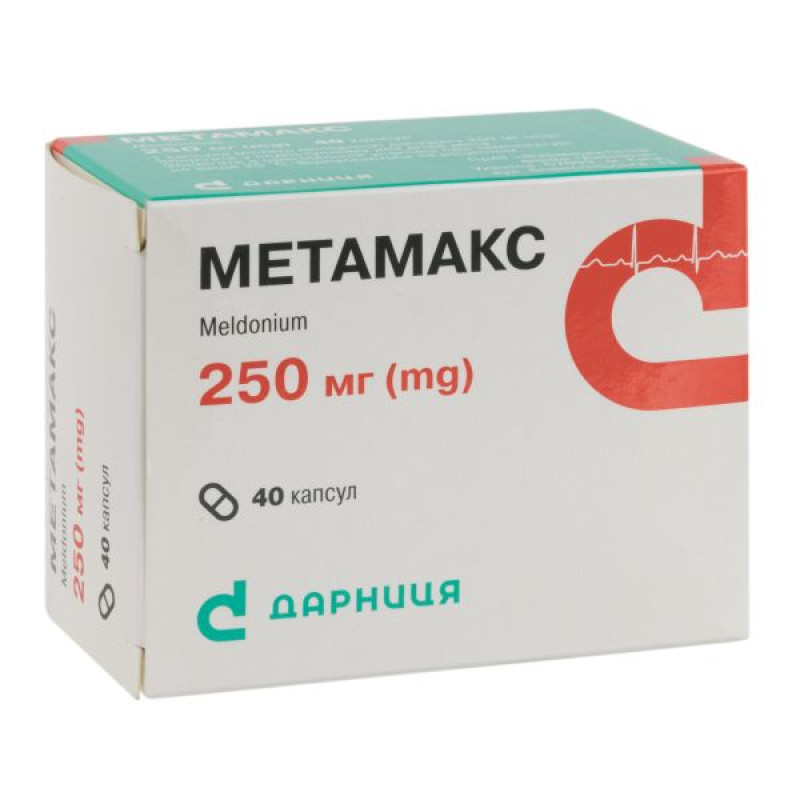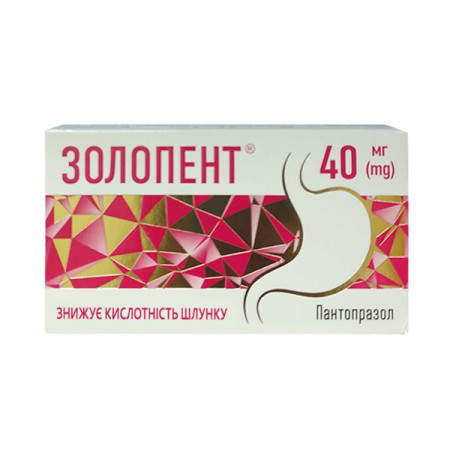Metamax capsules 250 mg No. 40

Instructions for Metamax capsules 250 mg No. 40
Composition
active ingredient: meldonium dihydrate;
1 capsule contains meldonium dihydrate 250 mg;
excipients: potato starch, colloidal anhydrous silicon dioxide, magnesium stearate;
hard gelatin capsules: gelatin, titanium dioxide (E 171).
Dosage form
Capsules.
Main physicochemical properties: hard gelatin capsules with a white cap and body, containing a white or white with a yellow tint powder with a faint odor.
Pharmacotherapeutic group
Other cardiological drugs. Meldonium. ATC code C01E B22.
Pharmacological properties
Pharmacodynamics.
Meldonium dihydrate is a structural analogue of γ-butyrobetaine, which improves metabolism and energy supply of cells.
The drug inhibits the activity of γ-butyrobetaine hydroxylase, reduces the content of free carnitine, reduces carnitine-dependent oxidation of fatty acids. In conditions of ischemia, it restores the balance of oxygen delivery and consumption in cells, prevents impaired transport of adenosine triphosphate (ATP), and at the same time activates glycolysis, which occurs without additional oxygen consumption. As a result of a decrease in the concentration of carnitine, γ-butyrobetaine is synthesized more intensively, which is characterized by vasodilator properties.
The mechanism of action of meldonium determines a wide range of its pharmacological effects. It increases working capacity, reduces symptoms of mental and physical overload. In heart failure, it increases myocardial contraction, tolerance to physical exertion, and reduces the frequency of angina attacks.
In acute and chronic ischemic disorders of cerebral circulation, meldonium improves blood circulation in the ischemic focus, promoting the redistribution of cerebral blood flow in favor of the ischemic area.
Meldonium also has a tonic effect on the central nervous system, it eliminates functional disorders of the somatic and autonomic nervous system, including withdrawal syndrome in patients with chronic alcoholism. The drug also has a positive effect on dystrophically altered retinal vessels and on cellular immunity.
Pharmacokinetics.
After oral administration, the drug is rapidly absorbed from the gastrointestinal tract. Its bioavailability is 78%. The maximum concentration in blood plasma is reached 1-2 hours after administration. It is metabolized in the body with the formation of two main metabolites, which are excreted by the kidneys. The half-life is 3-6 hours.
Indication
As part of complex therapy in the following cases:
− diseases of the heart and vascular system: stable angina pectoris, chronic heart failure (NYHA, I-III functional class), cardiomyopathy, functional disorders of the heart and vascular system;
− acute and chronic ischemic disorders of cerebral circulation;
− reduced working capacity, physical and psycho-emotional overstrain;
− during the recovery period after cerebrovascular disorders, head injuries and encephalitis.
Contraindication
− Hypersensitivity to any of the components of the medicinal product.
− Increased intracranial pressure (in case of impaired venous outflow, intracranial tumors).
− Organic lesions of the central nervous system.
− Severe liver and/or kidney dysfunction, severe liver and/or kidney failure (there is insufficient data on the safety of use).
− Pregnancy or breastfeeding.
− Childhood (up to 18 years old).
Interaction with other medicinal products and other types of interactions
The drug can be combined with antianginal agents, anticoagulants and antiplatelet agents, antiarrhythmic agents, cardiac glycosides, diuretics and other drugs.
Metamax may potentiate the effects of nitroglycerin, nifedipine, β-blockers, antihypertensives, and peripheral vasodilators and cause the development of moderate tachycardia and hypotension (caution should be exercised when using this combination).
When used simultaneously, Metamax enhances the effect of antianginal agents, some antihypertensive drugs, and cardiac glycosides.
Do not use simultaneously with other medicines containing meldonium (risk of adverse reactions).
As a result of the simultaneous use of iron and meldonium preparations in patients with iron deficiency anemia, the composition of fatty acids in red blood cells improved.
When meldonium is used in combination with orotic acid to reverse ischemia/reperfusion injury, an additional pharmacological effect is observed.
During pentylenetetrazole-induced seizures, a pronounced anticonvulsant effect of meldonium was established. In turn, when the α2-adrenergic blocker yohimbine at a dose of 2 mg/kg and the nitric oxide synthase (NOS) inhibitor N-(G)-nitro-L-arginine at a dose of 10 mg/kg were used before therapy, the anticonvulsant effect of meldonium was completely blocked.
Meldonium overdose may enhance cardiotoxicity caused by cyclophosphamide.
Carnitine deficiency resulting from the use of meldonium may enhance cardiotoxicity caused by ifosfamide.
Meldonium has a protective effect against indinavir-induced cardiotoxicity and efavirenz-induced neurotoxicity.
Application features
Metamax is not a first-line drug in the treatment of acute coronary syndrome. If the patient has a history of mild or moderate liver and/or kidney dysfunction, caution should be exercised when using the drug (liver and/or kidney function should be monitored). The drug should be used in the morning.
Use during pregnancy or breastfeeding
Pregnancy. The safety of the drug during pregnancy has not been proven. To avoid possible adverse effects on the fetus, Metamax should not be prescribed during pregnancy.
Breastfeeding. Available animal data indicate that meldonium is excreted in human milk. It is not known whether meldonium is excreted in human milk. A risk to the newborn/infants cannot be excluded, therefore meldonium is contraindicated during breast-feeding.
The ability to influence the reaction speed when driving vehicles or other mechanisms.
Given the possibility of developing adverse reactions (decreased blood pressure, tachycardia), when taking the drug, driving vehicles and working with other mechanisms that require increased attention and speed of reaction should be avoided.
Method of administration and doses
Administer orally to adults. Swallow capsules whole with water. The drug is used regardless of meals. Due to the possible stimulating effect, the drug should be used in the morning.
Adults.
Cardiovascular diseases, cerebrovascular disorders.
The dose is 500-1000 mg per day. The daily dose can be taken all at once or divided into 2 doses. The maximum daily dose is 1000 mg.
Reduced performance, overexertion and recovery period.
The dose is 500 mg per day. The daily dose can be taken all at once or divided into two single doses. The maximum daily dose is 500 mg.
The duration of the treatment course is 4-6 weeks. The treatment course can be repeated 2-3 times a year.
Elderly patients.
Elderly patients with impaired liver and/or kidney function may require a reduction in the dose of meldonium.
Patients with renal impairment.
Since the drug is excreted from the body by the kidneys, patients with mild to moderate renal impairment should use a lower dose of meldonium.
Patients with liver dysfunction.
Patients with mild to moderate liver impairment should use a lower dose of meldonium.
Children.
There is no data on the safety and efficacy of meldonium in children and adolescents under the age of 18, therefore the use of this medicine in children and adolescents is contraindicated.
Overdose
Cases of overdose are unknown. The drug is low-toxic and does not cause dangerous side effects. With low blood pressure, headaches, dizziness, tachycardia, and general weakness are possible.
Treatment: symptomatic. In cases of severe overdose, it is necessary to monitor kidney and liver function. Hemodialysis is of no significant importance in case of meldonium overdose due to pronounced protein binding.
Adverse reactions
Adverse reactions are classified by system organ class and frequency according to MedDRA: common (≥ 1/100, < 1/10), uncommon (≥ 1/1000, ≤ 1/100), rare (≥ 1/10000, ≤ 1/1000), very rare (≤ 1/10000).
Respiratory, thoracic and mediastinal disorders: common: respiratory tract infections; rare: sore throat, cough, dyspnea, apnea.
Gastrointestinal: often - dyspepsia*; rarely - dysgeusia (metallic taste in the mouth), loss of appetite, nausea, vomiting, flatulence, diarrhea, abdominal pain, dry mouth or hypersalivation.
On the part of the kidneys and urinary system: rarely - pollakiuria.
Nervous system: often - headaches*; rarely - paresthesias, tremor, hypoesthesia, tinnitus, dizziness, gait disturbance, pre-syncope, fainting.
On the part of the psyche: rarely - excitement, feelings of fear, obsessive thoughts, sleep disturbances.
Cardiovascular system: rarely - palpitations, tachycardia/sinus tachycardia, atrial fibrillation, arrhythmia, chest discomfort/chest pain, increase/decrease in blood pressure, hypertensive crisis, flushing, pallor of the skin.
Skin and subcutaneous tissue disorders: rarely - rash, generalized macular/papular rash, itching.
Musculoskeletal and connective tissue disorders: rarely - back pain, muscle weakness, muscle spasms.
General disorders and administration site conditions: rarely - general weakness, chills, asthenia, facial edema, leg edema, feeling hot, feeling cold, cold sweat.
Laboratory indicators: often - dyslipidemia, increased C-reactive protein levels;
rarely - electrocardiogram (ECG) abnormalities, eosinophilia*.
*Adverse effects observed in previously conducted uncontrolled clinical trials.
Reporting of suspected adverse reactions.
Reporting suspected adverse reactions after the marketing authorisation of a medicinal product is an important procedure. It allows for continued monitoring of the benefit-risk balance of the medicinal product in question. Healthcare professionals should report any suspected adverse reactions via the national reporting system.
Expiration date
2 years.
Storage conditions
Store in the original packaging at a temperature not exceeding 25 ºС.
Keep out of reach of children.
Packaging
10 capsules in a contour blister pack; 4 contour blister packs in a pack.
Vacation category
According to the recipe.
Producer
PrJSC "Pharmaceutical Company "Darnitsa".
Location of the manufacturer and address of its place of business.
Ukraine, 02093, Kyiv, Boryspilska St., 13.
There are no reviews for this product.
There are no reviews for this product, be the first to leave your review.
No questions about this product, be the first and ask your question.














